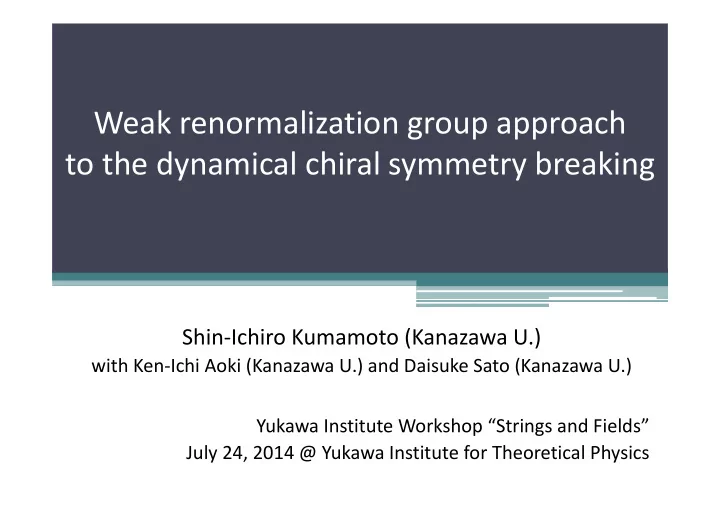

Weak renormalization group approach to the dynamical chiral symmetry breaking Shin ‐ Ichiro Kumamoto (Kanazawa U.) with Ken ‐ Ichi Aoki (Kanazawa U.) and Daisuke Sato (Kanazawa U.) Yukawa Institute Workshop “Strings and Fields” July 24, 2014 @ Yukawa Institute for Theoretical Physics
Introduction Spontaneous symmetry breaking in 2D Ising model G �, � : Gibbs free energy ���, �� : Helmholtz free energy � : Magnetization � : External field � : Temperature � : Temperature Nondifferentiable point (2nd order phase transition)
Dynamical chiral symmetry breaking in the Nambu - Jona ‐ Lasinio model (0 density) � � ��, �� : Legendre effective potential � � ��, �� : Wilsonian effective potential �� �� � : Bilinear fermion operator � � : Chiral condensate � � : Renormalization scale parameter � : Renormalization scale parameter Nondifferentiable point �� � 0 � (Mass generation)
• Wilsonian effective potential � � ��, � � is obtained as the solution of the nonperturbative renormalization group equation (NPRGE). • The singular solution ( � � � � ) is not the “usual solution ” of the partial differential equation (PDE). PDE is not satisfied. • We’ll authorize such a singular solution which describes the phase transition. We introduce the "weak solution" as the mathematically extended notion of solution, which can have some nondifferentiable points. K ‐ I. Aoki, S ‐ I. Kumamoto and D. Sato PTEP 2014 043B05
Table of Contents 1. Nonperturbative renormalization group equation (NPRGE) 2. Weak solution 3. Results 4. Summary
1. Nonperturbative renormalization group equation Partition function Lower modes Higher modes � ��� ��; Λ� : Wilsonian effective action Includes higher mode effect ( � � Λ ) Remaining variable of integration Nonperturbative renormalization group equation (Functional differential equation) This functional differential equation (FDE) can not be solved. We reduce the FDE to a partial differential equation by some approximation.
Local potential approximation for fermions Wilsonian effective potential Nonperturbative renormalization group equation (1st order PDE) Initial condition (Finite density NJL model) We reduce the PDE to a system of ordinary differential equations (ODEs).
The method of characteristics ( PDE ⇒ system of ODEs) Change of variables NPRGE Hamilton ‐ Jacobi type equation ( ���, �� : concave in �� ( ���, �� : convex in � ) Characteristic equations Canonical equations
Wilsonian effective potential � � ��, �� ( � � � 0 , � � 1.7 � � � , � � 0.7 , � � 0, 0.4, 0.5, 0.6, 0.717, 10 ) Multi ‐ valued solution Physical single ‐ valued solution Nondifferentiable We introduce the weak solution which is a single ‐ valued and singular solution.
2. Weak solution Hamilton ‐ Jacobi equation ( ���, �� : singular solution ) Add the viscosity term (second derivative with respect to � ). Viscous Hamilton ‐ Jacobi equation ( � � ��, �� : regularized smooth solution ) viscosity term Viscosity solution (weak solution of H ‐ J eq.) M.G. Crandall and P.-L. Lions, Trams. Amer. Math. Soc . 277 277, 1 (1983).
How to calculate viscosity solution There are two major methods of calculation for viscosity solution. Vanishing viscosity method (Definition of viscosity solution) • 1. Calculate the regularized smooth solution � � ��, �� . 2. Take the limit Convert to the optimality control problem • 1. Replace the initial value problem of Hamilton ‐ Jacobi equation with a completely different problem which is called the “optimality control problem”. 2. Calculate the value function which is equivalent to the viscosity solution. We solve the optimality control problem to calculate the viscosity solution.
Optimal control problem Cost functional : Lagrangian (given) Initial action (given) Value function ( Optimal control problem is to find the path � ∗ ��� which minimizes ���� . ) It is known that the value function is equivalent to the viscosity solution of the Hamilton ‐ Jacobi equation.
Dynamic programming (Method to calculate the value function) Optimality condition Discretize ��, �� plane Value function at � ��� Short ‐ time action … … Value function is given in this area. … … 1. Calculate the short ‐ time action and the value function for all lattice points of � ��� respectively. 2. Find the minimum point in the points of � ��� to give us the value function ��� � , � � � .
3. Results ( ) Viscosity solution � � ��, �� is the continuous and maximum brunch solution.
Wilsonian effective potential Legendre effective potential Legendre effective potential (solid line) is a convex envelope of the numerical result of the characteristic equations (broken line).
Wilsonian effective potential Legendre effective potential The viscosity solution of NPRGE convexifies the Legendre effective potential. The convex Legendre effective potential has the global minimum only which corresponds to the vacuum.
5. Summary • The NPRGE of the NJL model is the H ‐ J type equation and the solution has some singularities. • The viscosity solution (weak solution) is a single ‐ valued and singular solution. • The obtained viscosity solution perfectly describes the physically correct vacuum even in the case of the first order phase transition appearing in a finite ‐ density medium, which is also demonstrated by the auto ‐ convexification of the Legendre effective potential. Wilsonian effective potential � � ��, �� Legendre effective potential � � ��, �� Challenges for the future • We are going to apply this method to the finite temperature and density QCD and improve the local potential approximation to the 2nd order PDE.
Recommend
More recommend